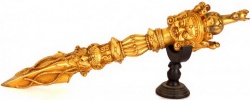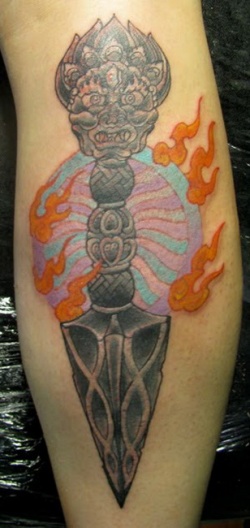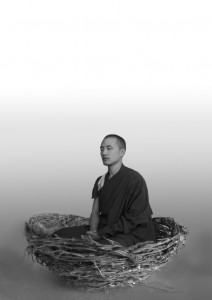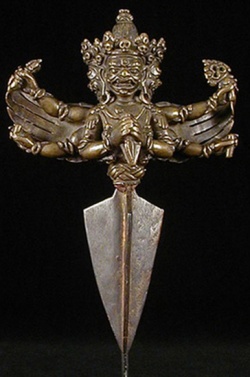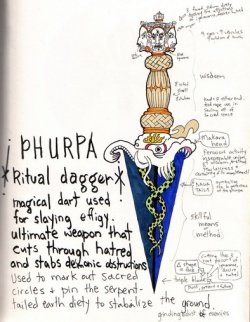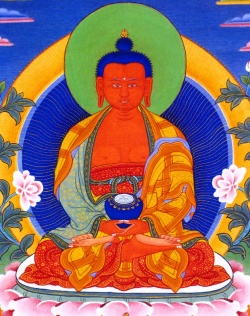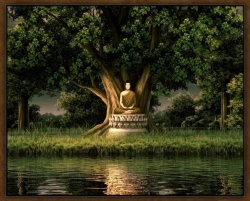Kīla (Buddhism)
The kīla (Sanskrit Devanagari: कील; IAST: kīla; Tibetan: ཕུར་བ, Wylie: phur ba, pronunciation between pur-ba and pur-pu, alt. transliterations and English orthorographies: phurpa, phurbu, purbha or phurpu)
is a three-sided peg, stake, knife, or nail like ritual implement traditionally associated with Indo-Tibetan Buddhism, Bön, and Indian Vedic traditions. The kīla is associated with the meditational deity (Srkt:ishtadevata, Tib. yidam) Vajrakīla ( वज्रकील) or Vajrakīlaya (Tib. Dorje Phurba). according to the means for attainment Mahayoga class. Vajrakilaya is the Buddha's activity natural expression representation.
Etymology
Most of what is known of the Indian kīla lore has come by way of Tibetan culture. Scholars such as F. A. Bischoff, Charles Hartman and Martin Boord have shown that the Tibetan literature widely asserts that the Sanskrit for their term phurba is kīlaya (with or without the long i).
However, as Boord describes it, "all dictionaries and Sanskrit works agree the word to be kīla (or kīlaka).
I suppose this (discrepancy) to result from an indiscriminate use by Tibetans of the dative singular kīlaya.
This form would have been familiar to them in the simple salutation namo vajrakīlaya (homage to Vajrakīla) from which it could easily be assumed by those unfamiliar with the technicalities of Sanskrit that the name of the deity is Vajrakīlaya instead of Vajrakīla.
It should also be noted that the term (vajra)kīlaya is frequently found in Sanskrit texts (as well as in virtually every kīlamantra) legitimately used as the denominative verb 'to spike,' 'transfix,' 'nail down,' etc."
Mayer (1996) contests Boord's assertion, pointing out that eminent Sanskritists such as Sakya Pandita employed Vajrakīlaya. Further, he argues:
- it is possible, on the other hand, that the name Vajrakīlaya as favoured by the Tibetans could in fact have been the form that was actually used in the original Indic sources, and that there is no need to hypothesize a correct form "Vajrakīla".
"Vajrakīlaya" could have come from the second person singular active, causative imperative, of the verb Kīl. Indigenous grammar (Pāṇini Dhātupāṭha I.557) gives to Kīl the meaning of bandha, i.e.
"to bind", while Monier-Williams (285) gives the meanings "to bind, fasten, stake, pin". Hence the form kīlaya could mean "you cause to bind/transfix!", or "bind/transfix!".
This, taken from mantras urging "bind/transfix", or "may you cause to bind/transfix", might have come to be treated as a noun; and the noun might then have become deified;
hence Kīlaya might have started out as a deified imperative, in some ways comparable to the famous example of the deified vocative in the name Hevajra, and a not unheard of phenomenon in Sanskrit tantric literature.
This suggestion is supported by Alexis Sanderson, a specialist in Sanskrit tantric manuscripts whom I consulted on this problem.
Fabrication and components
The fabrication of kīla is quite diverse. Having pommel, handle, and blade, kīla are often segmented into suites of triunes on both the horizontal and vertical axes, though there are notable exceptions.
This compositional arrangement highlights the numerological importance and spiritual energy of the integers three (3) and nine (9).
Kīla may be constituted and constructed of different materials and material components, such as wood, metal, clay, bone, gems, horn or crystal.
Wooden kīla are favored by shamans for healing and energetic work.
Like the majority of traditional Tibetan metal instruments, the kīla is often made from brass and iron (terrestrial and/or meteoric iron.
'Thokcha' (Tibetan: ཐོག་ལྕགས, Wylie: thog lcags) means "sky-iron" in Tibetan and denote tektites and meteorites which are often high in iron content.
Meteoric iron was highly prized throughout the Himalaya where it was included in sophisticated polymetallic alloys such as Panchaloha for ritual implements.
The pommel of the kīla often bears three faces of Vajrakīla, one joyful, one peaceful, one wrathful, but may bear the umbrella of the ashtamangala or mushroom cap, ishtadevata (like Hayagriva), snow lion, or stupa, among other possibilities.
The handle is often of a vajra, weaving or knotwork design.
The handle generally has a triune form as is common to the pommel and blade.
The blade is usually composed of three triangular facets or faces, meeting at the tip.
These represent, respectively, the blade's power to transform the negative energies known as the "three poisons" or "root poisons" (Sanskrit: mula klesha) of attachment/craving/desire, delusion/ignorance/misconception, and aversion/fear/hate.
Ritual usage
Cantwell and Mayer (2008) have studied a number of texts recovered from the cache of the Dunhuang manuscripts that discuss the phurba and its ritual usage.
The kīla is one of many iconographic representations of divine "symbolic attributes" (Tibetan: phyag mtshan) of Vajrayana and Hindu deities.
When consecrated and bound for usage, the kīla are a nirmanakaya manifestation of Vajrakīlaya.
Chandra, et al. (1902: p. 37) in their Dictionary entry 'korkor' (Tibetan: ཀོར་ཀོར, Wylie: kor kor) "coiled" (English) relates that the text titled the 'Vaidūry Ngonpo' (Tibetan: བཻ་དཱུརྱ་སྔོན་པོ, Wylie: bai dUry sngon po) has the passage: ཐག་བ་ཕུར་བ་ལ་ཀོར་ཀོར་བྱམ "a string was wound round the (exorcist's) dagger (phurba)."
One of the principal methods of working with the kīla and to actualize its essence-quality is to pierce the earth with it; sheath it; or as is common with Himalayan shamanic traditions, to penetrate it vertically, point down into a basket, bowl or cache of rice (or other soft grain if the kīla is wooden).
The terms employed for the deity and the tool are interchangeable in Western scholarship. In the Himalayan shamanic tradition the kīla may be considered as axis mundi.
Müller-Ebelling, et al. (2002) affirm that for the majority of Nepalese shaman, the kīla is cognate with the world tree, either in their visualisations or in initiatory rites or other rituals.
The kīla is used as a ritual implement to signify stability on a prayer ground during ceremonies, and only those initiated in its use, or otherwise empowered, may wield it.
The energy of the kīla is fierce, wrathful, piercing, affixing, transfixing.
The kīla affixes the elemental process of 'Space' (Sanskrit: Ākāśa) to the Earth, thereby establishing an energetic continuum.
The kīla, particularly those that are wooden are for shamanic healing, harmonizing and energy work and often have two nāgas (Sanskrit for snake, serpent and/or dragon, also refers to a class of supernatural entities or deities) entwined on the blade, reminiscent of the Staff of Asclepius and the Caduceus of Hermes.
Kīla often also bear the ashtamangala, swastika, sauwastika and/or other Himalayan, Tantric or Hindu iconography or motifs.
As a tool of exorcism, the kīla may be employed to hold demons or thoughtforms in place (once they have been expelled from their human hosts, for example) in order that their mindstream may be re-directed and their inherent obscurations transmuted.
More esoterically, the kīla may serve to bind and pin down negative energies or obscurations from the mindstream of an entity, person or thoughtform, including the thoughtform generated by a group, project and so on, to administer purification.
The kīla as an iconographical implement is also directly related to Vajrakilaya, a wrathful deity of Tibetan Buddhism who is often seen with his consort Diptacakra (Tib. khor lo rgyas 'debs ma).
He is embodied in the kīla as a means of destroying (in the sense of finalising and then freeing) violence, hatred, and aggression by tying them to the blade of the kīla and then transmuting them with its tip.
The pommel may be employed in blessings.
It is therefore that the kīla is not a physical weapon, but a spiritual implement, and should be regarded as such.
The kīla often bears the epithet Diamantine Dagger of Emptiness (see shunyata).
As Müller-Ebelling, et al. (2002: p. 55) states:
- The magic of the Magical Dagger comes from the effect that the material object has on the realm of the spirit.
The art of tantric magicians or lamas lies in their visionary ability to comprehend the spiritual energy of the material object and to willfully focus it in a determined direction. . .
The tantric use of the phurba encompasses the curing of disease, exorcism, killing demons, meditation, consecrations (puja), and weather-making.
The blade of the phurba is used for the destruction of demonic powers.
The top end of the phurba is used by the tantrikas for blessings.
As Beer (1999: p. 277-278) states, transfixing kīla , charnel ground, scorpion and Padmasambhava:
- The sting of the scorpion's whip-like tail transfixes and poisons its prey, and in this respect it is identified with the wrathful activity of the ritual dagger or kīla.
Padmasambhava's biography relates how he received the siddhi of the kīla transmission at the great charnel ground of Rajgriha from a gigantic scorpion with nine heads, eighteen pincers and twenty-seven eyes.
This scorpion reveals the kīla texts from a triangular stone box hidden beneath a rock in the cemetery.
As Padmasambhava reads this terma text spontaneous understanding arises, and the heads, pincers, and eyes of the scorpion are 'revealed' as different vehicles or yanas of spiritual attainment.
Here, at Rajgriha, Padmasambhava is given the title of 'the scorpion guru', and in one of his eight forms as Guru Dragpo or Pema Drago ('wrathful lotus'), he is depicted with a scorpion in his left hand.
As an emblem of the wrathful kīla transmission the image of the scorpion took on a strong symbolic meaning in the early development of the Nyingma or 'ancient school' of Tibetan Buddhism...".
Cultural context
To work with the spirits and deities of the earth, land and place, indigenous people of India, the Himalayas and the Mongolian Steppe pegged, nailed and/or pinned down the land.
The nailing of the kīla is comparable to the idea of breaking the earth (turning the sod) in other traditions and the rite of laying the foundation stone.
It is an ancient shamanic idea that has common currency throughout the region; it is prevalent in the Bön tradition and is also evident in the Vajrayana tradition.
According to shamanic folklore current throughout the region, "...the mountains were giant pegs that kept the Earth in place and prevented it from moving."
(Kerrigan, et al., 1998: p27) Mountains such as Amnye Machen, according to folklore were held to have been brought from other lands just for this purpose. Stupa (compare cairn) are a development of this tradition and akin to kīla.
(Kerrigan, et al., 1998: p27) states that:
- "Prayer flags and stone pillars throughout the country also pierce the land. Even the pegs of the nomads’ yak wool tents are thought of as sanctifying the ground that lies beneath...".
Traditions such as that of the kīla may be considered a human cultural universal in light of foundation stone rites and other comparable rites documented in the disciplines of anthropology and ethnography; e.g.,
turning of the soil as a placation and votive offering to spirits of place and to preparation of the land as a rite to ensure fertility and bountiful yield.
Traditional lineage usage: anthology of case studies
In the Kathmandu Valley, the kīla is still in usage by shamans, magicians, tantrikas and lamas of different ethnic backgrounds. The kīla is used particularly intensively by the Tamang, Gurung and Newari Tibeto-Burmese tribes.
The kīla is also employed by the Tibetans native to Nepal (the Bhotyas), the Sherpas, and the Tibetans living in Dharamasala.
Müller-Ebelling, et al. (2002: p. 29) chart the difference of the kīla traditions between the jhankris and the gubajus:
- The phurbas of the gubajus are different from those of the jhankris. As a rule, they have only one head on which there is a double vajra as shown here.
Gubajus focus on the head as a mirror image of themselves in order to meditatively connect with the power of the phurba.
The three or more heads of the upper area of the phurba indicate the collection of energies that the jhankris use.
A "Bhairab kīla" is an important healing tool of the tantric Newari gubajus. As Müller-Ebelling, et al. (2002: p. 55) state:
- Tantric priests (guruju) use Bhairab phurbas for the curing of disease and especially for curing children's diseases. For these cases the point of the phurba blade is dipped into a glass or a bowl of water, turned and stirred.
The sick child is then given the magically charged water as medicine to drink.
Müller-Ebelling, et al. (2002: p. ?) interviewed Mohan Rai.
(Mohan Rai is a shaman from the border area of Nepal and Bhutan and belongs to the Mongolian people of the Rai and/or Kirati.
Mohan Rai is the founder of the Shamanistic Studies and Research Centre, Baniya Goun, Naikap, Kathmandu, Nepal) who in an interview is directly quoted as saying:
- 'Without the phurba inside himself , the shaman has no consciousness'...'The shaman himself is the phurba; he assumes its form in order to fly into other worlds and realities.'
Therefore to extrapolate, the kīla is identified with consciousness and the root of sentience, the buddha-nature.
Müller-Ebelling et al. (2002) affirm that some Kukri may be considered kīla, as ultimately, everything that approximates a vertical form. The kīla then is a phallic polysemy and cognate with lingam ~ the generative instrument of Shiva that is metonymic of the primordial energy of the Universe.
The kīla as lingam, actualizes the yoni essence-quality of whatever it penetrates.
The wrathful heruka Vajrakilaya is a meditation deity who embodies the energetic 'activity' (Wylie: phrin las) of all the buddhas, manifesting in a powerful and wrathful yet compassionate form in order to subjugate the delusion and negativity that can arise as obstacles to the practice of Dharma.
Vajrakīla (Vajrakīlaya)
Dzongsar Khyentse Rinpoche on the practice of Vajrakilaya states that:
- "Vajrakilaya, or kīla, means something sharp, and something that pierces – a dagger.
A dagger that is so sharp it can pierce anything, while at the same time nothing can pierce it.
That is the quality. This sharp and piercing energy is what is used to practice and out of the many infinite, endless Vajrayana methods this happens to be one of most important methods."
As deity
Vajrakilaya is a significant Vajrayana deity who transmutes and transcends obstacles and obscurations. Vajrakila is the divine 'thoughtform' (Tibetan: སྤྲུལ་པ།, Wylie: sprul pa) that governs the kīla.
Padmasambhava achieved realisation through practicing 'Yangdag Heruka' (Tibetan: yang dag he ru ka) but he first practiced Vajrakilaya to clean and clear obstacles and obscurations.
Vajrakilaya is also understood as the embodiment of activities of the Buddha mind.
Sometimes Vajrakilaya is perceived as the wrathful vajrayana form of Vajrapani, according to Dilgo Khyentse Rinpoche.
Many great masters both in India and Tibet, but especially in Tibet, have practiced Vajrakilaya (especially in the Nyingma lineage, and among the Kagyu and also within the Sakyapas).
The Sakyapa's main deity, besides Hevajra is Vajrakumara or Vajrakilaya.
Jamyang Khyentse Wangpo, Dilgo Khyentse Rinpoche, Dudjom Rinpoche and a significant number of lamas within the Kagyu and Nyingma engaged Vajrakilaya sadhana.
Iconography
Vajrakilaya (also known as Vajrakumara) is the deity of the magic thundernail, the kīla, a tool of the sharp adamantine point of dharmakaya, a wisdom forded through the power of one-pointed concentration.
This 'one-pointed' (Sanskrit: eka graha) focus is a concerted mindfulness on the unity and interdependence of all dharmas.
This one-pointed focus is understood as 'applying oneself fully' (Tibetan: sgrim pa). Vajrakilaya is a favoured tantric archetypal deity embraced by the Nyingmapa.
The awesome and wrathful manifestation of this empty yet apparent deity assists practitioners in clearing the obstructions to realization.
A common manifestation of Vajrakilla has three heads, six arms, and four legs.
Vajrakilaya's three right hands except for the right front one held vajras with five and nine prongs.
The right front one makes a mudra as granting boons with open palm. Vajrakilaya's three left hands hold a flaming triple wishfulfilling jewel or triratna, a trident and the kilaya.
Vajrakilaya's back is covered by the freshly flayed skin of the elephant representing 'ignorance' (Sanskrit: avidya; Wylie: marigpa), with the legs tied in front.
A human skin is tied diagonally across his chest with the hands lying flat on Vajrakilaya's stomach and solar plexus representing the flailed ego that has released its powerful grip obscuring the 'qualities' of the Sadhaka.
Qualities are represented iconographically by the 'vortex' (Sanrkit: chakra; Wylie: Khorlo) of the Manipura (Sanskrit: Maṇipūra).
A rope ripples over his body with severed heads hanging by their hair representing the Akshamala or 'garland of bija' (Sanskrit: Varnamala).
A knee length loin cloth winds around his belly belted with a tiger skin complete with tail, claws and head.
This deity wears manifold nāga adornments and jewellery: naga earrings, naga bracelets, naga anklets and a naga cord over his chest, sometimes referred to as a naga gurdle and a naga hairpiece or hair ornament.
Vajrakilaya's faces are round and small compared to the tall body.
Despite the large fangs and bulging eyes and his wrathful appearance, Vajrakilaya is perceived as having a benevolent demeanor.
History of Vajrakilaya practice in India and Tibet
Although at one point the Indic origin of kīla practice was widely questioned, Boord claims that "the existence of a Kīla cult among the Buddhists in eighth century India...must now surely be accepted as established" and further claims that it has been "conclusively demonstrated that all the basic doctrines and rituals of Vajrakīla had their origin in India."
Robert Mayer, one of the leading scholars of the kīla literature, shares the same view, writing that prior research had been plagued by "elementary misunderstandings" based on a lack of familiarity with crucial Indic primary sources.
Mayer says of Boord's work, "our understandings of the deity are quite similar" insofar as both do not doubt that "the phur-pa and the deity are Indic."
Tibetan tradition, which Boord credits as generally credible, holds that the entire corpus of Indian kīla lore was systematized by Padmasambhava, Vimalamitra, and the Nepali Śīlamañju, while on retreat together at Yang-le-shod (present-day Pharping, Nepal).
According to Boord, "it was precisely during this retreat that the many strands of kila lore were finally woven together into a coherent masterpiece of tantric Buddhism and thus it helps to illuminate the process by which tantric methods were being related to soteriology at this time.
Beautifully codified in terms of both theory and practice, this divine scheme of meditation and magic was subsequently transmitted to Tibet and became established there as one of the major modes of religious engagement.
So much so, in fact, that many previous writers on Tibet have actually assumed the kila cult to be of Tibetan origin."
Renowned Tibetologist and Buddhologist Herbert Guenther concurred in a review of Boord's work, concluding that his "careful research of all available texts relevant to the study of this figure" was "much needed and long overdue" in correcting longstanding "misrepresentation of historical facts."
Beer (1999: p. 246) conveys the entwined relationship of Vajrakilaya with Samye, the propagation of Secret Mantra in Tibet, and the importance of the sadhana to both Padmasambhava's enlightenment, and his twenty-five 'heart disciples', who are of the mindstreams of the principal terton (according to Nyingma tradition):
- In the biography of Padmasambhava it is recorded that he travelled to the northern land of Kashakamala, where the cult of the kīla prevailed.
Later, whilst meditating on the deity Yangdak Heruka (Skt. Vishuddha Heruka) in the 'Asura Cave' at Parping in the Kathmandu valley, he experienced many obstructions from the maras, and in order to subjugate them he request the Kīla Vitotama Tantras to be brought from India.
Having established the first Tibetan monastery at Samye, the first transmission that Padmasambhava gave to his 25 'heart disciples', in order to eliminate the hindrances to the propagation of the buddhadharma in Tibet, were the teachings of the Vajrakilaya Tantra.
From its early Nyingma origins the practice of Vajrakilaya as a yidam deity with the power to cut through any obstructions was absorbed into all schools of Tibetan Buddhism.
There are a number of terma teachings founded on Vajrakilaya. For instance, there are treasure teachings from Jigme Lingpa, Ratna Lingpa and Nyang-rel Nyima Ozer.
Vajrakilaya Puja within the Sakyapa and others
Vajrakilaya Puja has long unbroken lineage within the Sakyapa. Vajrakilaya Puja was received by Khön Nagendra Rakshita and his younger sibling Vajra Ratna from Padmasambhava.
Since then it has been transmitted in the Khön lineage and has been enacted every year until the present.
Even in the challenging times of 1959 His Holiness the Sakya Trizin maintained the tradition.
The Rigpa Sangha of Sogyal Rinpoche practises several Vajrakilaya sadhanas. The empowerment of Khön Tradition of Vajrakilaya has been given to the Rigpa sangha by H.H. Sakya Trizin at Lerab Ling, 22–23 June 2007 .
Examples of practice in history
- "Princess Sakyadevi was the daughter of King Sukkhadhara of Nepal. Her mother died in childbirth and she was displaced by the next queen and abandoned by the court. When she grew up she became a Yogini and resided near present day Parphing, in the mountains just outside the Kathmandu Valley. There she is said to have become a consort of Guru Padmasambhava and received teachings from him. The two lived together at the yogi's cave of Langlesho, above Parphing, where they mastered Vajrakilaya-practice. It is said that she eventually attained "Rainbow Body" as a realized female Buddha.",.
- "During the empowerment of Assemblage of Sugatas, her (Yeshe Tsogyal's) initiation flower fell on the mandala of kīla. Through this practice she became able to tame evil spirits and revive the dead."
In popular culture
The 1986 film The Golden Child features a magical phurba called the Ajanti Dagger which has the ability to kill mystical beings, specifically the titular child and the demon Sardo Numspa.
In the 1994 movie The Shadow, the phurba was a dangerous weapon which moved of its own accord. In the 2009 video game Uncharted 2: Among Thieves, a golden phurba is the key to the mythical kingdom of Shambhala.
